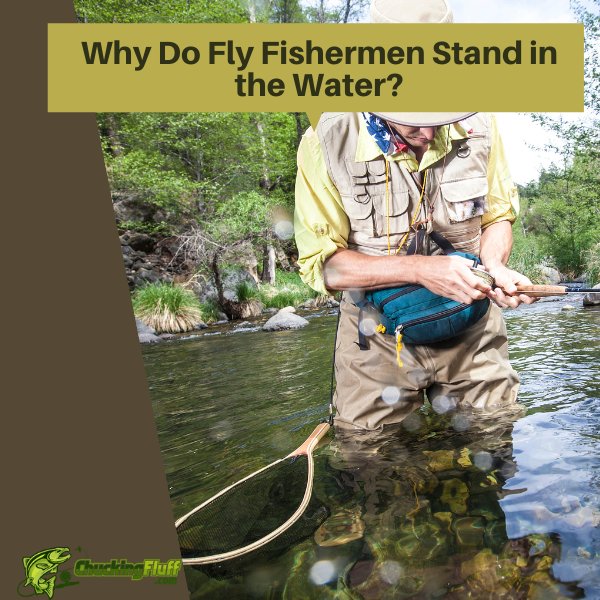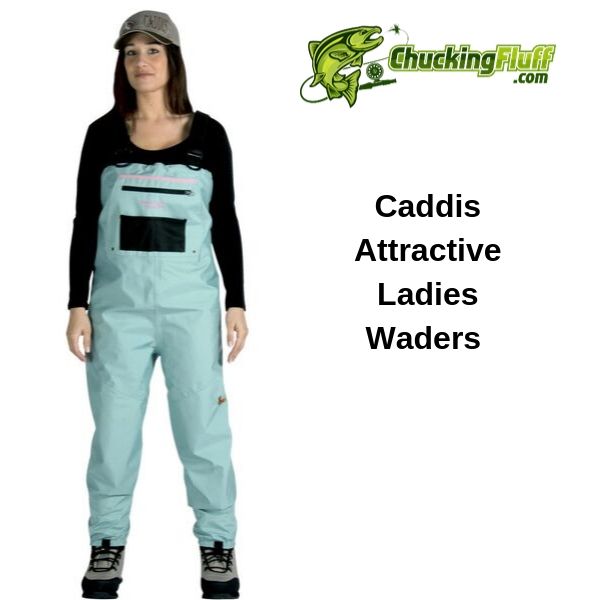| Disclosure: Just to be open and honest the buttons and links you click on in the website will in most cases take you to another website where you can purchase the products I am reviewing. As an Amazon Associate I earn from qualifying purchases. |
Why Do Fly Fishermen Stand in the Water? Wade to Catch

Sounds quite cliché but it baffles non-anglers why fly anglers have to be in the water.
The old man would say, only the shoe wearer knows where it pinches – slightly different in the fly fishing field since only the fly caster knows why they are in water and not swimming.
So, why do fly fishermen stand in water?
| Fly anglers stand in the water to help with fly positioning as they fish downstream. Besides, they want to be closer to the fish because most are furthest from the shores or banks. Anglers in water love it since they are distanced from snags and hindrances often close to the river banks. Such a position improves your cast’s accuracy to the fish without getting too close to them even though you actually should. Mind your distance even as you closely approach a target. It takes a split second for them to notice something unusual and bolt to seek cover. |
Quick Post Navigation
Why Do Fly Fishermen Stand in the Water?
You will spot most fly fishers standing in water donned in chest waders for warmth and comfort, but these are necessary for cold days.
The movement is mostly from shallow to deeper water hence the length of the waders.
Here’s why anglers stand in water while fly fishing.
To Reach More Fish
Fish are always hiding, especially when they are full, when the water and external temperatures are adverse, or when they are used to seeing bubbly lures and have known that that’s how they’ll leave their home.
Don’t assume them, fish are smart and will stay off the predator’s path by going deeper into the water surface or further from the banks.
The only time you’ll probably see fish is if they come to the surface to eat or when in shallow crystal clear waters.
Understanding the behavior of fish you are after beforehand will aid in knowing their feeding lanes and water patterns.
Escape Brush and Hindrances
There are times when you are ready to hit that spot but the brush and trees behind you become a good anchor point for your line.
Overhead fly casting becomes almost impossible when it was the only technique you had mastered.
You can stand in the water, position yourself a little closer to your target but right behind it to avoid spooking it and do the thing!
Such an easy way to avoid snagging your flies while maximizing your throws.
Shore bound fly fishers are often frustrated by thick trees when fishing unless they try out roll casting or bow and arrow casting techniques.
For The Right Position and Correct Presentations
Fishing from the shores requires you to cast the line upstream even though it will eventually float downstream as it heads towards the edges.
Fly fishing while standing in the water means the fly will move forward and backwards and if you are in an area with brushes, the position ensures you avoid snags and get the fly to where you intend it to go.
When it comes to getting the right position, you’ll need to make a slightly wide stance for firmness.
Try lowering your centre of gravity (COG) and flex your knees in case the flow is stronger.
You want to be in open space all around you for easy casting.
FAQs on Standing in Water While Fly fishing
Here are more brief answers to questions on why fly fishermen stand in water.
The questions are inexhaustible, but we’ll cover those whose answers are difficult to find online.
Q) Which Surfaces Are Best for Standing on When Fly Fishing?
A) Gravel and sand river, stream, and lake bottoms are the safest for standing on.
Cobble is challenging to wade on because of the unsteady and irregular surface which could be algae-covered.
Be cautious about bedrock, taller rocks, and firm mud as these are slippery and will trip you anytime you are unsteady.
It becomes difficult to fly fish if you are slipping every minute – if anything you risk being swept by the currents if you lose balance.
A wading staff will assist here greatly.
- Bungee corded collapsible design folds down to 12inch
- Open up in one hand when needed
- Carbide steel tip
- 3/4inch aluminum alloy tubing
- Contoured EVA grip with wrist strap
Q) Can You See Your Feet Fly Fishing While Standing in Water?
A) It depends on the clarity and depth of the water.
Your feet will be visible in clear and shallow waterbodies and impossible to see in deep and murkier waters.
For clarity, you should be able to see your feet when wading above the knee else the water is too dirty for fly angling.
Find your footing by starting low and sliding your feet ahead between the rocks to get where you are stepping.
It is crucial to master how to find footing in shallower waters before advancing to further depths.
Soon, you’ll learn how to work on your stance while maintaining wide feet as you take steps.
The only fear of moving without seeing where you are stepping is slipping.
Q) Are There Limitations to When You Can Stand in Water To Fly Fish?
A) Yes, first things first, never stand in water when tipsy, feeling drowsy, or unwell.
Water knows no pity and the results can be detrimental.
Stay on the banks or shore if the water is more treacherous and rough to stand in.
For seasons, winter and autumn are for the advanced fly anglers to take this position.
Novices should stick to boating or river bank fishing until it is spring or summer.
Evaluate your health conditions, sobriety, weather conditions and river bottom before standing in water to fly fish.
Wrap Up
Fly fishing while standing in water has a different experience from constantly boating or casting from the banks.
The fact that you are exposed to more waters (even though boating gives the best exposure) means you can hit your catch limit faster and drop your scale severally.
Besides, throwing your line is smoother because of reduced hindrances like brushes and hanging tree branches.
These give you a chance to use your flies and keep them since snagging isn’t an issue.
Overall, you want to be knowledgeable of safety and water bottom evaluation before attempting to stand in water.
Get the right wading boots for grip and chest waders for warmth if fly fishing in low temperatures.
Be keen not to spook fish because you might spend the whole day playing Tom and Jerry.
Last update on 2025-07-16 / Affiliate links / Images from Amazon Product Advertising API
This product presentation was made with AAWP plugin.



